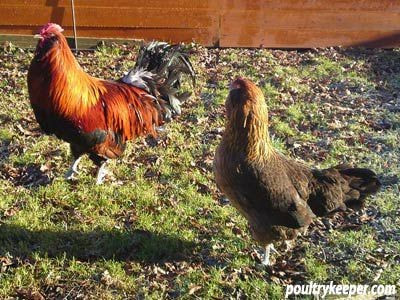The Appenzell Canton is the north-eastern part of Switzerland. It is not known how long Spitzhaubens have been bred there, but the very similar Brabanter from The Netherlands was depicted in seventeenth century paintings, so Appenzeller Spitzhaubens may date from the same period. The Appenzeller Barthuhner was developed in the 1860s from crosses between Brown Leghorns, Russian Beardeds and Polveraras (now extinct, related to Bearded Polands). Kurt Fischer, of Stuttgart - Zuffenhausen, Germany, was a leading breeder in the revival of both breeds in the 1950s, as they had almost died out during World War Two.
General characteristics: male
Carriage: Strong and active.
Type: Body well rounded, medium long with broad shoulders. Breast full, carried high. Wings moderate, tucked in close to the body. Tail well furnished, carried like a fan with abundant sickle feathers. Back of medium length, slightly sloping with full saddle hackle.
Head: Medium size, with a medium size rose comb with good, rounded working and a straight leader. Wattles small, covered by a full cheek and chin beard. Large beak and nostrils. Eyes prominent and alert.
Neck: Medium length, slightly arched with abundant hackle.
Legs and feet: Thighs well developed, shanks of medium length with no feathering. Four toes, well spread.
Plumage: Fairly tight.
Female
Except for a more horizontal back line, the general characteristics are the same as for the male, allowing for the natural sexual differences.
General characteristics: male
Carriage: Strong and active.
Type: Body well rounded, medium long with broad shoulders. Breast full, carried high. Wings moderate, tucked in close to the body. Tail well furnished, carried like a fan with abundant sickle feathers. Back of medium length, slightly sloping with full saddle hackle.
Head: Medium size, with a medium size rose comb with good, rounded working and a straight leader. Wattles small, covered by a full cheek and chin beard. Large beak and nostrils. Eyes prominent and alert.
Neck: Medium length, slightly arched with abundant hackle.
Legs and feet: Thighs well developed, shanks of medium length with no feathering. Four toes, well spread.
Plumage: Fairly tight.
Female
Except for a more horizontal back line, the general characteristics are the same as for the male, allowing for the natural sexual differences.
Please contact the breed registrar for more information


